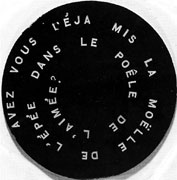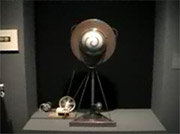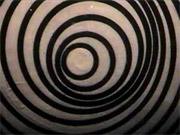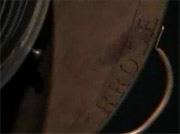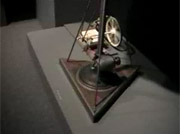SinceCourbet, it’s been believed that painting is addressed to the retina.That was everyone’s error. The retinal shudder! Before, painting had other functions: it could be religious, philosophical, moral. If I had a chance to take an antiretinal attitude, it unfortunately hasn’t changed much; our whole century [the twentieth] is completely retinal,except for the Surrealists, and still they didn’t go so far!(1)
click to enlarge
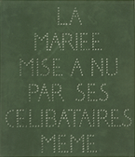
Figure. 1
Marcel Duchamp, The Green
Box, 1934
Marcel Duchamp’s comment is very strange when one considers the number of his works that involve the distinctly retinal phenomena of optical illusions; these works, produced mainly in the 1920’s, he termed “precision optics.” Optical illusions are an important part of his work because of their unusual characteristics: they present multiple ‘interpretations’ which cannot all be ‘true’ at the same time, but which are nevertheless ‘correct’ ways to see the work. They allow him to incorporate a systematic destabilizing of vision in the system which he attempted to create in the 1910s, and which was presented inThe Green Box (Fig. 1). The systems Duchamp constructed are inconsistent. They produce contradictions which are incorporated into their meaning. In the case of “precision optics,” this inconsistency is a physical component of the work due to the action of the illusions themselves:
But let us now say exactly what is meant by consistency of a formal system… that every theorem, when interpreted becomes a true statement. And we will say that inconsistency occurs when there is at least one false statement among the interpreted theorems.(2)
Optical illusions present images which are “true” but inconsistent. The lines which form the pulsating illusion in Duchamp’s “precision optics” gain their meaning only from the relationship we choose for them; our internal decision that one orientation is more probable than another results in its apparent shift between these mutually-exclusive spatial positions, and understanding it requires the acceptance of these potentials as being a “probability set.” This is why these images are technically inconsistent–they present incompatible versions of themselves. Visual forms of this ‘class’ offer a liminal experience–one where the process of seeing becomes visible in/through that process itself. The optical illusion is a liminal experience; it allows a visualization of the process of interpretation which is normally unconscious. Vision is rendered regressive by optical illusions.
The name ‘rotoreliefs’ refers to optical illusions which appear as three-dimensional forms when displayed on a rotating surface(Fig. 2)such as a phonograph turntable. Superficially, they present an apparent contradiction to this prohibition against “retinal art.”‘ Once in motion they display a pulsating “relief” that oscillates between positive and negative space. Duchamp used these illusions in Anémic Cinéma (1926)(Fig. 3) alternating them with a series of French puns, each arranged into a spinning spiral:
Something else happens when we begin to allow the puns to have their play. The figurative meaning of “la moelle de l’épée” and “la poele de l’aimée” over powers the literal (non)sense.The reference to sexual intercourse could hardly be more evident.Furthermore, once we recognize its figurative character, our readingof the other disks begins to reveal sexual allusions. …Suddenly the abstract gyrating shapes which rise from and sink into the plane of the screen come to resemble the igloos, breasts, welts and genitalia evoked by the words. The sexuality is neither in the literal meaning
of the words, nor represented in the optical illusions, seen by themselves.(3)
click images to enlarge
- Figure 2
Marcel Duchamp, Rotoreliefs, 1935
(machine modeled after 1964 version
created by Vittorio Marchi and
Robert Slawinski) - Figure3
Marcel Duchamp, Disk Inscribed with Pun
for Anemic Cinema, 1926.
P. Adams Sitney recognized that sexuality is the subtext to this film, but it is a subtext which requires the interpretation of the viewer looking at the juxtaposition of rotorelief and the text. The meaning produced is an overlay onto the image; this overlay does not resolve the issue of the (potential) retinal nature of these images. The sexuality which Sitney notes is a result of the punning character of the statements; these “word plays” act through a double meaning which becomes apparent when they are read aloud. The doubling of the puns parallels the doubling of the ‘rotoreliefs.’ The gyrating shapes Sitney describes are theretinal aspect of the ‘rotoreliefs.’ This effect originates in the inconsistency of human perception which optical illusions exploit. It is the interpretative shift of the “precision optics” which moves the experience of looking from the purely visual into the mental realm:
“Painting should not be exclusively visual or retinal. It must interest the gray matter; our appetite for intellectualization.”(4)
click to enlarge

Figure. 4
Marcel Duchamp, The Bride Stripped
Bare by Her Bachelors, Even [ The
Large Glass], 1915-1923
“Retinal art” does not promote an intellectual response; that is only the initial effect / impression which this art produces. Duchamp’s conversion of this retinal impression in Anémic Cinéma into sexuality is connected to the system of construction he presented in The Green Box (1934). Inconsistency also enters into “precision optics” becauseThe Large Glass (Fig. 4)is an attempt at a complete formalized system of sexual congress; this is what the notes in The Green Boxdescribe.’The “mathematical” bias to the construction notes demonstrates Duchamp’s concern with formal systems. His system creates a linguistic formalism, derived from the abstract system of mathematics. It allows his introduction of a ‘formal’ component into the work provided that the viewer is aware of the system he employs:
Conditions of a language:
The search for “prime words” (“divisible” only by themselves and by unity).
Take a Larousse dict. and copy all the so-called “abstract” words. i.e., those which have no concrete reference Compose a schematic sign designating each of these words. (this sign can be composed with the standard stops) These signs must be thought of as the letters of the new alphabet.(5)
The invention of new “signs” for an abstract language corresponding to terms in a dictionary without concrete reference divests language of its meaning, allowing its manipulation in purely technical terms. His proposal parallels what Hilbert attempted to do for mathematics.The Bride Stripped Bare by Her Bachelors, Even Duchamp claims is the result of the system which The Green Box documents. The meaning of “abstract” words appears only through their contextual usage. Duchamp suggests what he means by this in his text called *the. While the search for “prime words” and all that entails may be an unrealizable proposal, the new “signs” which become the letters of a “new alphabet” would logically be used to produce a new, formal and abstract language in the same sense that Hilbert’s formal system transforms the ordinary language of geometry into a new language. Kurt Gödel demonstrated in 1932 that formal systems such as Hilbert’s produce inconsistencies which are inherent to logic:
Gödel showed (i) how to construct an arithmeticalformula G that represents the meta-mathematical statement: ‘The formula G is not demonstrable.’ This formula G thus ostensibly says
of itself that it is not demonstrable. … But (ii) Gödel also showed that G is demonstrable if, and only if, its formal negation ~ G is demonstrable.(6)
Gödel’s proof is based on a paradox: Theorem G is demonstrable only if it is not demonstrable, but to demonstrate that it is demonstrable is to show that it isn’t. The appearance of this infinite regression of logical consequence arises because G is inconsistent; in the formal system of logic, its construction is both correct and invalid at the same moment. The statement is a true statement of logic that cannot be true. The paradox which G’del produces is one that follows the formal rules for the logical system of symbolic mathematics from which the description above is a translation; that system is thus inconsistent:
Gödel’s paper is proof of the impossibility of demonstrating certain postulates… The traditional belief that the axioms of geometry (or, for that matter, the axioms of any discipline)
can be established by their apparent self-evidence was thus radically undermined. …For it became evident that mathematics is simply the discipline par excellence that draws the conclusions logically implied by any given set of axioms or postulates.(7)
click to enlarge

Figure. 5
Marcel Duchamp, The Standard
Stoppages, 1913-14
In general terms, what G’del demonstrates is that the set of assumptions which provide the foundation for logical certainty have an arbitrary basis because they can be shown to produce inconsistency. In epistemological terms, formalized knowledge derived from logic is in itself an inconsistent proposition; this is Gödel’s Theorem.(8)Duchamp’s work, most obviously in his optical illusions, proceeds from a similar use of paradox to undermine the formal system he proposes. The parameters of that language are suggested by Duchamp’s work–the reference to The Standard Stoppages (1913-14) (Fig. 5) as the unit of measure places the “signs” inside his physical oeuvre.
Viewed by themselves and not as part of the film, the ‘rotoreliefs’ become optical illusions only when they are in motion. Until that happens, they are circular geometric signs. Understanding them as objects requires considering them as they appear when moving and stationary; in motion, their most evident feature is the illusion of space which they evoke.
To lose the possibility of recognizing (identifying) 2 similar objects — 2 colors, 2 laces, 2 hats, 2 forms whatsoever to reach the Impossibility of sufficient visual memory, to transfer from one like object to another the memoryimprint.
— Same possibility with sounds; with brain facts.(9)
The “loss” Duchamp describes implies a transformation of the retinal into a mental construction of the type which optical illusions typically present: they provide two similar objects contained in a single image which defies our ability to easily visualize it.(10) The experience of optical illusions allows us to look at “seeing.” In apprehending these illusions we do transfer the memory from one image to the next; that is how we recognize the oscillation between the two positions. In a comment published in 1948, Duchamp echoed his note from The Green Box:
Senses:
One can look at seeing. Can one hear hearing, feel breathing, etc. . . . ?(11)
By “look at seeing” Duchamp describes the particular interpretative effect which accompanies optical illusions. The ‘rotoreliefs” visual oscillation only results from spinning the disks. There is a double contrast here: between static image and the motion image, as well as between the two interpretations of the illusion of positive and negative volumes. It is not possible to “see” both volumes at the same time just as it is not possible to experience the illusion while the disk is stationary. The shift from one volume to the other makes the observer aware of the way biological vision gets interpreted into “seeing.”
The encounter with the “space” which these illusions create is a delayed one–the machine that displays them must first be set in motion. Once that happens, the “space” of the illusion becomes immanent. However, this “space” is unstable as Anémic Cinéma demonstrates and Sitney observes: the illusions pulsate, apparently projecting outwards only to reverse their direction and recede. The volumes which the ‘rotoreliefs’ create are internally inconsistent–they present two mutually incompatible images at the same time. In looking at these objects, it is the process of interpretation which becomes apparent through the oscillation thatAnémic Cinéma connects with sexuality.
The oscillations of these optical illusions may be the “cinematic blossoming” produced by the Bride’s desire. Duchamp makes this condition apparent in his explanation of each component of the Large Glass:
The bride basically is a motor. …The whole graphic significance is for this cinematic blossoming. This cinematic blossoming is by the electrical stripping (see the passage of the
bach. machine to the bride) … The last state of this nude bride before the orgasm which may (might) bring about her fall graphically, the need to express in a completely different way from the rest
of the painting, this blossoming.(12)
The appearance of the ‘rotoreliefs’ in a film called Anémic Cinéma is not coincidental; it is explicitly related to the Large Glass. This note suggests that the “blossoming” cannot be presented in the same manner as the rest of the painting. The action of the pictured machinery will not actually appear within the painting itself. It is suggestive of the ‘rotoreliefs,’ especially due to their appearance in the film. The pulsating movement of the ‘rotoreliefs’ visibly resembles “blossoming.” That the “whole graphic action” of the Large Glass cannot be expressed by the same techniques as the painting is significant. The work may be technically “unfinishable”; part of its being left “incomplete” may be the depictive problem which is solved by optical illusions such as the ‘rotoreliefs.’
As with a record, the ‘rotoreliefs’ have a hole in the center which is registered on a pin centered on the turntable. The mounting of the disk presents a sexual metaphor which is repeated throughout Duchamp’s iconography. “Precision optics” presents’ an illusion of graphic movement which makes the reliefs appear when playing the disk. This activity is a replay of the action of the chocolate grinder. The static nature of the disk is “consumed” by setting it into motion:
Given an object in chocolate.
1st its appearance = retinal impression (and other sensory consequences)
2nd its apparition.
The mould of a chocolate object is the negative apparition of the plane with one or several curvatures) generating 1st (by elementary prllll-ism)the colored form of the object. 2nd the mass of elements of light (chocolate type elements): in the passage from apparition (mould) to the appearance, the plane, composed of elements of chocolate type light determines the apparent chocolate mass by physical dyeing(13)
Duchamp explicitly explains the transition from retinal to mental here. The senses the concept of “apparition” suggest: (1) the opposite of its retinal effect. This “sense” would mean that “apparition” is a mental state of perception for an object. (2) That the “apparition” appears discursively through a sequence of terms he sets in context. (Continuing the mathematical parallel, these are undefined terms in a Hilbert-type formalism where meaning appears through specific contextual use rather than a direct definition). The “apparition” is a visual effect that appears mentally through the “chocolate type light.” The chocolate object is consumed by the chocolate grinder to produce the illuminating gas for the bride machine.(14) The bride machine then begins moving to produce the “cinematic blossoming”–which is the action of the ‘rotoreliefs.’
Static imagery transforms into (both) mental and physically activity; the playing of a rotorelief on a phonograph thus recreates the action of the bachelor machine which fuels and makes active the bride. By playing the disk the audience takes the place of the bachelors. The bachelors are the force which sets Duchamp’s “mathematics” in motion. Theirs is a specific position in his system, one which repeats in his final work:
[In Etant Donnés…] Marcel Duchamp has determined forever exactly the amount of detail and precisely the fixed perspective that he wants the viewer to perceive. The illusion is complete in itself. Etant Donnés could be described as the alter ego of the Large Glass.(15)
click to enlarge

Figure. 6
Marcel Duchamp,
Given: 1. The Waterfall,
2. The Illuminating Gas,
1945-1966
Etant Donnés (1945-1966)(Fig. 6)is a large complex optical illusion. The fixed perspective / view places the audience looking through the door not only in the role of voyeur, but shifts the spectator into the role of the bachelors in the Large Glass. This action is repeated by the ‘rotoreliefs.’ It is important to remember that a phonograph of the type available in the 1920’s requires someone to crank the machine to set the disk into motion. The spectator “grinds” the “chocolate object” producing the “chocolate type light” which is the motion of the disk. Without this active participation nothing happens.
The apparition of the ‘rotoreliefs’ is after-the-fact of retinal stimulation: a “delayed” experience where the transfer from visual comprehension to intellectual comprehension is a change in mental state. That the work is an optical illusion reiterates the relationship as a “false” one. It cannot be both flat and dimensional at the same moment. The knowledge that it is flat and the perception of volume are incompatible. “Precision optics” are therefore inconsistent. Thus, perception of the finished piece is separated from its reality through the interpretation. Duchamp’s approach incorporates the inconsistency of observation that optical illusions exploit:
The figure [of Etant Donnés] is carefully designed to be seen as flattened and foreshortened by the perspective from a fixed eye-level viewpoint; the distant landscape background
and the immediate foreground of the door through which one looks are integral parts of the illusion.(16)
The optical component of these works, their “retinalism,” is an illusion: they are not physically as they appear, nor is their effect a result of their physical reality. Where theLarge Glass both excludes the audience (by incorporating them into some of the potential views), the later work replaces the bachelors with the audience. This shift appears specifically in the ‘rotoreliefs.’
Within this framework, the film Anémic Cinéma is rendered almost redundant through its literalization of the “cinematic blossoming” the ‘rotoreliefs’ demonstrate literally through cinema. The “anemia” of the title suggests an awareness of this redundancy by Duchamp and a connection between this awareness and the word “cinema” itself. The title is a near-palindrome, spelled the same forwards as backwards. It presents the problem of “2 similar objects” and allows the function of the puns and word-play of this film as derivable from the system of “prime words.” Each pun replays the action of the ‘rotoreliefs’ linguistically. It is a translation between the everyday language of “undefined terms” and the symbolic order which his formal notational system proposes. The role of “precision optics” is to present these “signs” in the form of new statements. Inconsistency plays a significant role in these works because they base their effect and thus their meaning on the encounter between the audience and the work itself.
At first sight Anémic Cinéma would seem to underline the difference between optical and verbal images. The two modes of representation are held together by the figure of the spiral. Yet we automatically apprehend them differently. The eye grasps the eccentric circles as if they were geometrical wholes. … While the view sees one set of disks as creating depth, he “reads” the other set as flat because of his reflex to the familiar orthography of the Latin alphabet. Thus,the viewer is the victim of an automatic response at odds with the ontological “sameness” of the shots.(17)
The translation of one set of terms into a statement within a formalized system is an action of rendering equivalences between one kind of notation and another. However, this action is only apparent to those who are aware of both formal systems; the sexual implication of the combination which Sitney notes, instead of simply being a juxtaposition of “neutral” content, is a logical combination within the system Duchamp calls “precision optics.” He applied that term to the Rotary Demisphere (1925) (Fig. 7a, b, c, d) and the ‘rotoreliefs’ generally. The “precision” of these works lies in the linkage between the retinal (optical illusion) and the formal logical system. This is more than just an iconographic connection; it is the literal relationship between equivalent terms in a mathematical formalism. While the retinal effect of the two kinds of presentation in Anémic Cinéma remains markedly different, it is also fundamentally the same mental sphere. Alternation in the sequence of the film demonstrates their interchangeability. While Sitney is correct that “the sexuality is neither in the literal meaning of the words, nor represented in the optical illusions, seen by themselves,” the formal system Duchamp devised is sexual: his art is representational within that system: thus sexual.
click images to enlarge
Marcel Duchamp, Rotary Demisphere, 1925
The appearance of the sexual content is built-in to his conception of “antiretinal.” The only group of artists which he believes also took an antiretinal attitude were the Surrealists. Given the sexual content of the mathematics at work in the ‘rotoreliefs’ and Etant Donnés…it is logical that Duchamp would feel Surrealism was also antiretinal is logical. The function of optical illusions in his later works is predicated on this translation of sexuality into visual forms. This is explicit in his final work. Inconsistency is inherent to this formulation not only because optical illusions exploit inconsistency as their form, but because the initial version of his formalized system presented in the Large Glass places the audience physically outside the system while at the same time including them in it:
The Large Glass and some of its studies are, of all Duchamp’s creations, the most accessible (to the point of being literally transparent) as well as the most abstruse. We see through them more than we see them. The viewer becomes part of the view.(18)
Anne d’Harnoncourt’s description of the Large Glass presents its inconsistency clearly through the combination of “accessible” and “abstruse.” This is a paradox. It cannot be both.That Duchamp’s art is paradoxical is self-evident: “we see through them more than we see them.” The transparency of the work is also its opacity. The inconsistency inherent to the optical illusion plays itself out intellectually and literally. “Precision optics”–Anémic Cinéma and the ‘rotoreliefs’–then, are important elements in the elaboration of Duchamp’sinconsistent system of formalized sexuality. There is a component of the rhetorical in Duchamp’s claims; for example, the system he claims produced the Three Standard Stoppages has been shown to be false.(19) The precision of the “precision optics” lies in the way that they translate these rhetorical positions and claims into the physical form of the objects themselves. This is the intellectualization Duchamp mentions being a partial component of Surrealism, but which “stopped short” because it does not completely subsume the work into the intellectual framework in the fashion that “precision optics” does.
Notes
 1. Pierre Cabanne, Dialogues with Marcel Duchamp, trans. Ron Padget(New York: Viking, 1971) 43.
1. Pierre Cabanne, Dialogues with Marcel Duchamp, trans. Ron Padget(New York: Viking, 1971) 43.
 2. Douglas R. Hofstadter, Gödel, Escher, Bach: An Eternal Golden Braid(New York: Basic Books, 1979,1999) 94.
2. Douglas R. Hofstadter, Gödel, Escher, Bach: An Eternal Golden Braid(New York: Basic Books, 1979,1999) 94.
 3. P. Adams Sitney, Modernist Montage (New York: Columbia University Press, 1990) 25.
3. P. Adams Sitney, Modernist Montage (New York: Columbia University Press, 1990) 25.
 4. Cleve Gray, “The Great Spectator” interview, Art in America,vol. 57, no. 4 (July-August, 1969) 21.
4. Cleve Gray, “The Great Spectator” interview, Art in America,vol. 57, no. 4 (July-August, 1969) 21.
 5. Marcel Duchamp, The Writings of Marcel Duchamp, ed. Michael Sanouillet and Elmer Peterson (New York: Da Capo Press, 1989) 31.
5. Marcel Duchamp, The Writings of Marcel Duchamp, ed. Michael Sanouillet and Elmer Peterson (New York: Da Capo Press, 1989) 31.
 6. Ernest Nagel and James R. Newman,Gödel’s Theorem (New York: New York University press, 1958, 1986) 58.
6. Ernest Nagel and James R. Newman,Gödel’s Theorem (New York: New York University press, 1958, 1986) 58.
 10. Anton Ehrenzweig, The Hidden Order of Art (Berkeley: University of California Press, 1976) 21-25.
10. Anton Ehrenzweig, The Hidden Order of Art (Berkeley: University of California Press, 1976) 21-25.
 11. Duchamp, Op. cit., p. 195.
11. Duchamp, Op. cit., p. 195.
 15. Anne d’Harnoncourt & Walter Hopps, Etant Donnés…: 1 la chute d’eau,2 le gaz d’eclairage: Reflections on a New Work by Marcel Duchamp,second reprint of the Philadelphia Museum of ArtBulletin,volume LXIV, numbers 299 and 300, April-September, 1969, with the 1973 afterword by Anne d’Harnoncourt (Philadelphia: Philadelphia Museum, 1987) 8.
15. Anne d’Harnoncourt & Walter Hopps, Etant Donnés…: 1 la chute d’eau,2 le gaz d’eclairage: Reflections on a New Work by Marcel Duchamp,second reprint of the Philadelphia Museum of ArtBulletin,volume LXIV, numbers 299 and 300, April-September, 1969, with the 1973 afterword by Anne d’Harnoncourt (Philadelphia: Philadelphia Museum, 1987) 8.
 17. Sitney, Op. cit., pp. 24-25.
17. Sitney, Op. cit., pp. 24-25.
 18. d’Harnoncourt, Op. cit., pp. 8-10.
18. d’Harnoncourt, Op. cit., pp. 8-10.
 19. Shearer, Rhonda Roland & Stephen Jay Gould. “Hidden in Plain Sight:Duchamp’s 3 Standard Stoppages, More Truly a “Stoppage” (An Invisible Mending) Than We Ever Realized“in Tout-Fait,Issue 1: Volume 1 (December 1999) News <http://www.toutfait.com/issues/issue_1/News/stoppages.html
19. Shearer, Rhonda Roland & Stephen Jay Gould. “Hidden in Plain Sight:Duchamp’s 3 Standard Stoppages, More Truly a “Stoppage” (An Invisible Mending) Than We Ever Realized“in Tout-Fait,Issue 1: Volume 1 (December 1999) News <http://www.toutfait.com/issues/issue_1/News/stoppages.html
Figs. 1~7
©2003 Succession Marcel Duchamp, ARS, N.Y./ADAGP, Paris. All
rights reserved.




